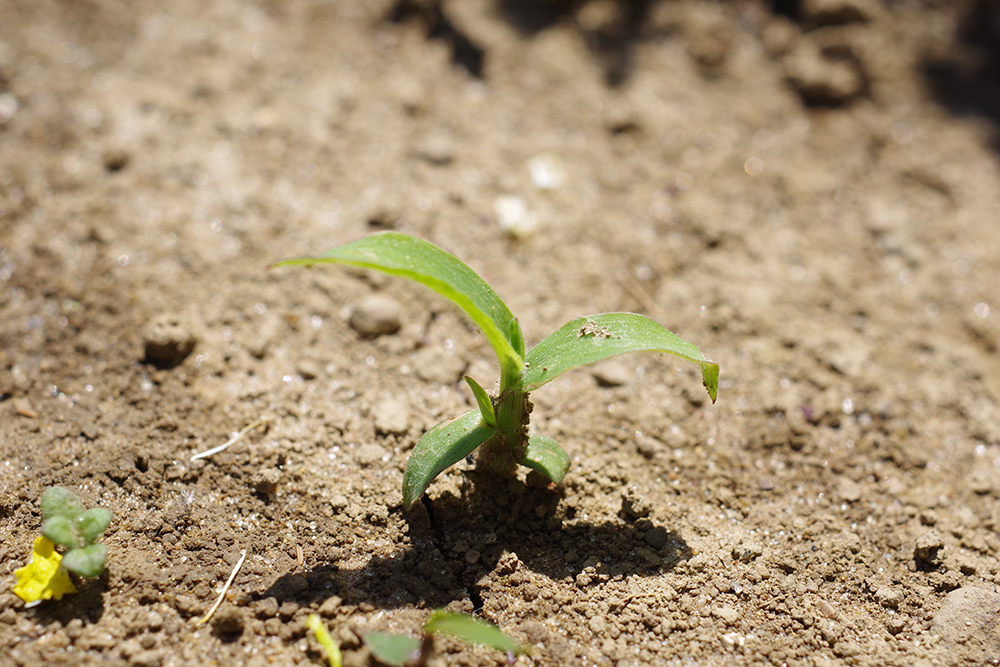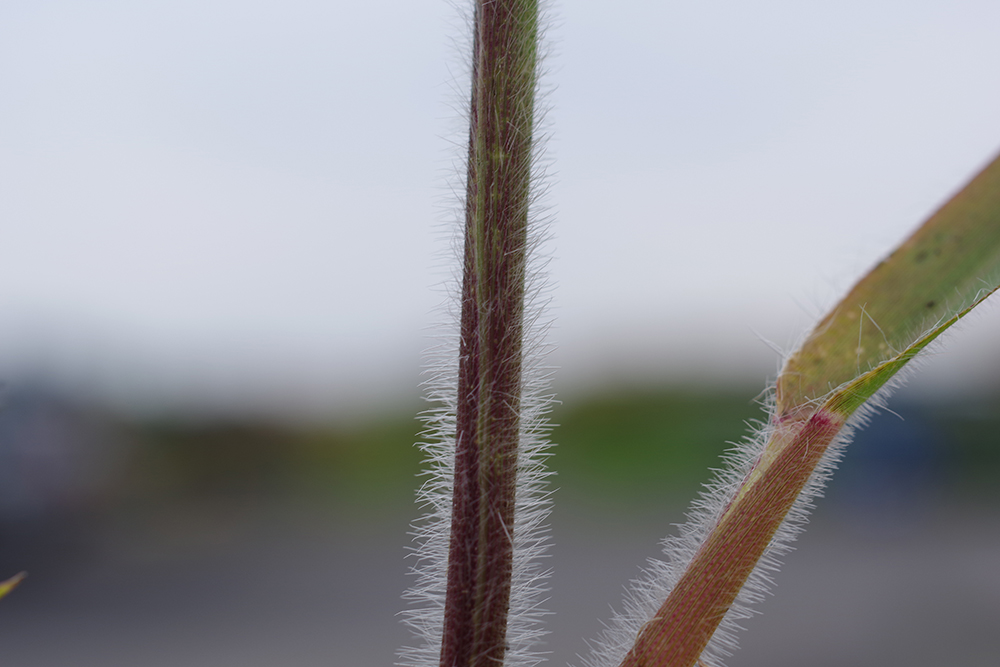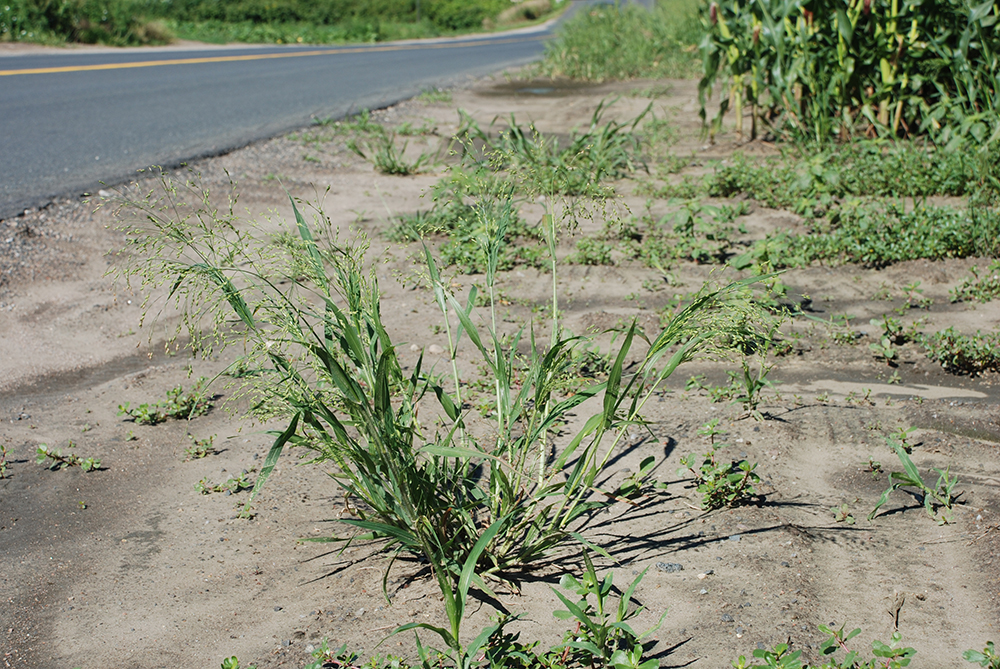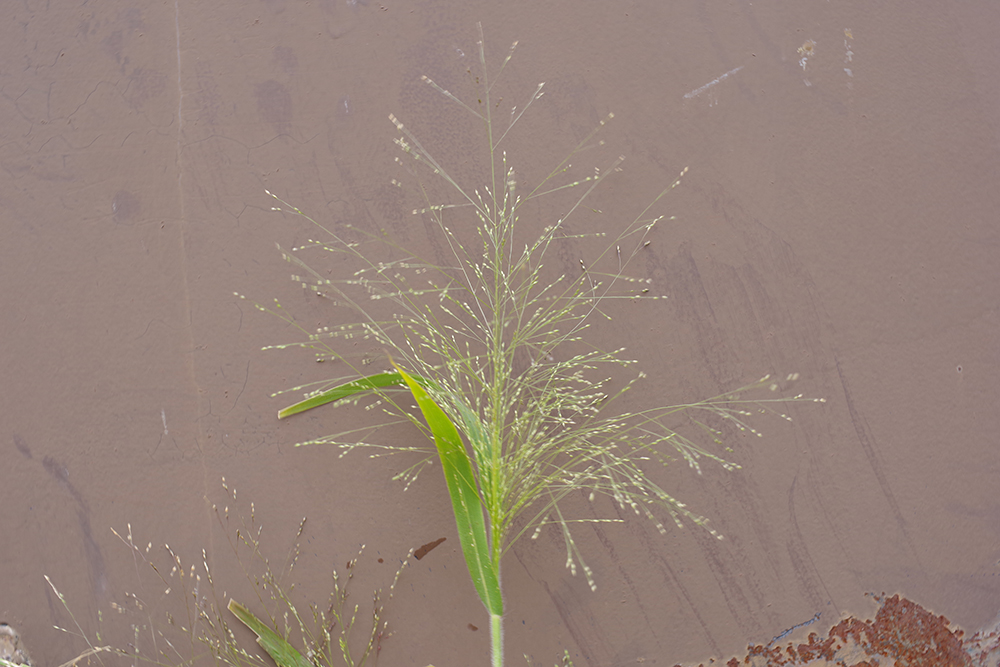Other common names: old witch grass, tickle grass, witches’ hair, tumble weed grass, fool hay




Panicum capillare L.
Identification of Witchgrass
Family: Grass family, Poaceae
Habit: Sprawling summer annual grass
Description: Seedlings are upright. The seed leaf is lanceolate, parallel to the ground and up to 0.5 inch long by 0.13 inch wide. Subsequent leaves are rolled in the bud, 0.6–1.6 inch long by 0.16–0.24 inch wide, pointed at the tip and lacking auricles. The collar is pale green to white, and the ligule is a 0.04–0.06 inch-long fringe of hairs. Long, silky hairs densely coat the sheath, collar and both leaf surfaces. The hairs are often thickened at the base. Mature plants are 8–36 inches tall and usually produce several tillers. Stems are round in cross section, either erect or horizontal, and spreading with upturned tips. The sheath is distinctly veined, green to purplish, and open. Leaf blades are flat, pale green, 2.3–10 inches long by 0.25–0.75 inch wide and have a conspicuous white midvein. The ligule and collar of seedlings and mature plants are similar. Both the sheath and the leaves are densely hairy. The roots are shallow and fibrous. Tillers root only at the base and not at stem joints. The inflorescence is a terminal, open, diffusely branching, 8–16 inch-tall and 3–9 inch-wide panicle. The panicle branches are rough, straight to wavy and 4.5–12 inches long. Each branch splits into several smaller branchlets, each of which has a single 0.08–0.13 inch-long, beaked spikelet at the tip. Each spikelet produces a single smooth, shiny, dark brown or gray seed. As with all grasses, the seed includes a thin, tight coating of fruit tissue. The seeds are oblong to egg shaped and 0.06–0.13 inch long.
Similar species: Crabgrasses (Digitaria spp.), fall panicum (Panicum dichotomiflorum Michx.) and wild-proso millet (Panicum miliaceum L.) have a similar appearance to witchgrass. Crabgrass seedlings are folded in the bud, lack sheath hairs and have membranous ligules, while witchgrass seedlings are rolled in the bud, have hairy sheaths and have a fringe of hairs as the ligule. The leaves of fall panicum seedlings are hairy only on the underside, while witchgrass leaves are hairy above and below, and fall panicum usually is a larger, more robust mature plant. Wild-proso millet also is a larger plant than witchgrass, reaching up to 4.25 feet in height with spikelets that are 0.18–0.2 inch long.
Management of Witchgrass
Since soil disturbance promotes almost 100% of witchgrass seeds near the surface to germinate, spring tillage can make this species highly susceptible to stale or false seedbed management that kills seedlings before planting summer crops. In contrast, late summer or fall fallow will usually prompt little germination. Because seedlings mostly emerge from the top 1 inch of soil and establish relatively slowly, tine weeding and other shallow, in-row weeding methods can be highly effective against this species. Due to their drought tolerance, burying young plants during cultivation may be more effective than partially uprooting them.
Avoid excessive N fertility since this will favor the weed relative to crops, particularly less vigorous crop species. Compared with many other weeds, witchgrass is a poor competitor and can be suppressed by a dense, vigorous crop or cover crop.
Ecology of Witchgrass
Origin and distribution: Witchgrass is native to eastern North America from southern Canada to Florida, and a western variety extends to the Pacific. Prior to agriculture, the species persisted on beaches, riverbanks and similarly open, disturbed habitats. It has been widely introduced into temperate areas of the world, including Europe, Asia, Australia, New Zealand and southern South America.
Seed weight: Mean population seed weights vary from 0.15–0.65 mg.
Dormancy and germination: Seeds are dormant when shed from the parent plant and require a period of cold, wet conditions before they are ready for germination. As seeds lose dormancy in spring, they require relatively high temperatures for germination (86–95°F in the day and 59–68°F at night). As spring progresses, the temperature required for germination declines. Light is required for germination, and when present with suitable temperatures, up to 100% of seeds will germinate. Alternating temperatures also are required for high levels of germination. If seeds do not germinate in the spring, they enter secondary dormancy during mid-summer. Since these dormant seeds require another period of chilling, seedling emergence declines substantially during the summer and fall. Dilute solutions of nitrate or ammonium promote germination.
Seed longevity: The seeds can live at least several decades in undisturbed soil, but there are no reports on estimated annual mortality rates. Given its propensity to germinate in light, longevity of seeds near the soil surface in regularly tilled soil is probably much lower than that of seeds buried deeper in soil.
Season of emergence: Witchgrass emerges primarily in late spring and early summer.
Emergence depth: Seeds emerge best from the top 0.5 inch of soil, and none emerge from 2 inches or deeper.
Photosynthetic pathway: C4
Sensitivity to frost: Plants die from the first frost.
Drought tolerance: Witchgrass is relatively drought tolerant and probably out-competes most crops during dry periods. It is more efficient than C4 crops like corn at using water for growth and much more efficient than C3 crops. Young plants have a herring-bone root arrangement that is highly effective at exploiting soil moisture.
Mycorrhiza: Witchgrass was rated as having moderate levels of mycorrhizal infection levels. Witchgrass biomass and P uptake were increased by inoculation with vesicular-arbuscular mycorrhizae at low available P levels.
Response to fertility: Witchgrass is highly responsive to nitrogen. Under high fertility it can accumulate N to the point of becoming toxic to livestock. It is also highly responsive to P but tolerates K and Ca deficiencies well. It is highly salt tolerant, and its ability to tolerate very high pH is indicated by its natural occurrence on alkali flats in the western United States.
Soil physical requirements: The species tolerates a wide variety of soil conditions but does best on sandy to loamy soils. It tolerates compaction.
Response to shade: Witchgrass tolerates moderate shade, but shade slows development and reduces dry matter and tillering. It does not thrive in areas with dense shade.
Sensitivity to disturbance: Witchgrass exists in primarily disturbed and cultivated habitats, resists trampling and sometimes invades overgrazed pastures. Its drought tolerance probably allows survival after partial uprooting during cultivation or hoeing. Because the inflorescence develops slowly, mowing before seed set can eliminate or greatly reduce seed production.
Time from emergence to reproduction: Early emerging witchgrass flowers about 8–13 weeks after emergence, with seeds maturing about 3.5 weeks later. Plants emerging in mid-summer develop more rapidly but are smaller and produce fewer seeds.
Pollination: Witchgrass self-pollinates but probably also cross-pollinates by wind. Under stressful conditions, the flowers often self-pollinate without opening.
Reproduction: A well-developed plant grown without competition in North Dakota produced 11,000 seeds. A very large plant produced 56,000 seeds.
Dispersal: The entire inflorescence breaks off as a unit and rolls as a tumble weed. Witchgrass is a common contaminant of forage seed like timothy and white clover, and contaminated forage and grain seed have been a major source for spreading throughout the world. The seeds float and commonly contaminate surface irrigation water, especially since the species often grows on stream banks. Seeds also disperse on tires, shoes and farm machinery. The seeds pass intact through horses, cattle, sheep and pigs, and are dispersed in feces and manure that is spread on fields.
Common natural enemies: The species is infected by a great variety of fungi and viruses, but their impact in agricultural situations has not been evaluated.
Palatability: No part of the plant makes a desirable food for humans. The plant is unpalatable to livestock except when very young, and it can contain toxic levels of nitrate when growing on highly fertile soils.
Summary table of Witchgrass Characteristics
| Witchgrass | ||||||||
|---|---|---|---|---|---|---|---|---|
| Growth habit | Seed weight (mg) | Seed dormancy at shedding | Factors breaking dormancy | Optimum temperature for germination (F) | Seed mortality in untilled soil (%/year) | Seed mortality in tilled soil (%/year) | Typical emergence season | Optimum emergence depth (inches) |
| short | 0.15–0.65 | Yes | cms, li, at, ni | 86/59 to 95/68 | na | – | late spring to early summer | 0–0.5 |
| Photosynthesis type | Frost tolerance | Drought tolerance | Mycorrhiza | Response to nutrients | Emergence to flowering (weeks) | Flowering to viable seed (weeks) | Pollination | Typical & high seed production (seeds per plant) |
| C4 | low | high | yes | high | 8–13 | 3–4 | self, can cross | na & 11,000 |
Table Key
General: The designation “–” signifies that data is not available or the category is not applicable.
Growth habit: A two-word description; the first word indicates relative height (tall, medium, short, prostrate) and second word indicates degree of branching (erect, branching, vining).
Seed weight: Range of reported values in units of “mg per seed.”
Seed dormancy at shedding: “Yes” if most seeds are dormant when shed, “Variable” if dormancy is highly variable, “No” if most seeds are not dormant.
Factors breaking dormancy: The principle factors that are reported to break dormancy and facilitate germination. The order of listing does not imply order of importance. Abbreviations are:
scd = seed coat deterioration
cms = a period subjected to cold, moist soil conditions
wst = warm soil temperatures
li = light
at = alternating day-night temperatures
ni = nitrates
Optimum temperature range for germination: Temperature (Fahrenheit) range that provides for optimum germination of non-dormant seeds. Germination at lower percentages can occur outside of this range. The dash refers to temperature range, and the slash refers to alternating day/night temperature amplitudes.
Seed mortality in untilled soil: Range of mortality estimates (percentage of seed mortality in one year) for buried seeds in untilled soil. Values were chosen where possible for seeds placed at depths below the emergence depth for the species and left undisturbed until assessment. Mortality primarily represents seed deterioration in soil.
Seed mortality in tilled soil: Range of mortality estimates (percentage of seed mortality in one year) for seeds in tilled soil. Values were chosen for seeds placed within the tillage depth and subjected to at least annual tillage events. Seed losses are the result of dormancy-breaking cues induced by tillage, germination and deterioration of un-germinated seeds.
Typical emergence season: Time of year when most emergence occurs in the typical regions of occurrence for each weed. Some emergence may occur outside of this range.
Optimum emergence depth: Soil depths (in inches below the soil surface) from which most seedlings emerge. Lower rates of emergence usually will occur at depths just above or just below this range.
Photosynthesis type: Codes “C3” or “C4” refer to the metabolic pathway for fixing carbon dioxide during photosynthesis. Generally, C3 plants function better in cooler seasons or environments and C4 plants function better in warmer seasons or environments.
Frost tolerance: Relative tolerance of plants to freezing temperatures (high, moderate, low).
Drought tolerance: Relative tolerance of plants to drought (high, moderate, low).
Mycorrhiza: Presence of mycorrhizal fungi. “Yes” if present; “no” if documented not to be present, “unclear” if there are reports of both presence and absence; “variable” if the weed can function either with or without, depending on the soil environment.
Response to nutrients: Relative plant growth response to the nutrient content of soil, primarily N, P, K (high, moderate, low).
Emergence to flowering: Length of time (weeks) after emergence for plants to begin flowering given typical emergence in the region of occurrence. For species emerging in fall, “emergence to flowering” means time from resumption of growth in spring to first flowering.
Flowering to viable seed: Length of time (weeks) after flowering for seeds to become viable.
Pollination: “Self” refers to species that exclusively self-pollinate, “cross” refers to species that exclusively cross-pollinate, “self, can cross” refer to species that primarily self-pollinate, but also cross-pollinate at a low rate, and “both” refers to species that both self-pollinate and cross-pollinate at relatively similar rates.
Typical and high seed production potential: The first value is seed production (seeds per plant) under typical conditions with crop and weed competition. The second value, high seed production, refers to conditions of low density without crop competition. Numbers are rounded off to a magnitude that is representative of often highly variable reported values.
Further Reading
Clements, D.R., A. DiTommaso, S.J. Darbyshire, P.B. Cavers and A.D. Sartonov. 2004. The biology of Canadian weeds. 127. Panicum capillare L. Canadian Journal of Plant Science 84: 327–341.
Vengris, J. and R.A. Damon, Jr. 1976. Field growth of fall panicum and witchgrass. Weed Science 24: 205–208.

